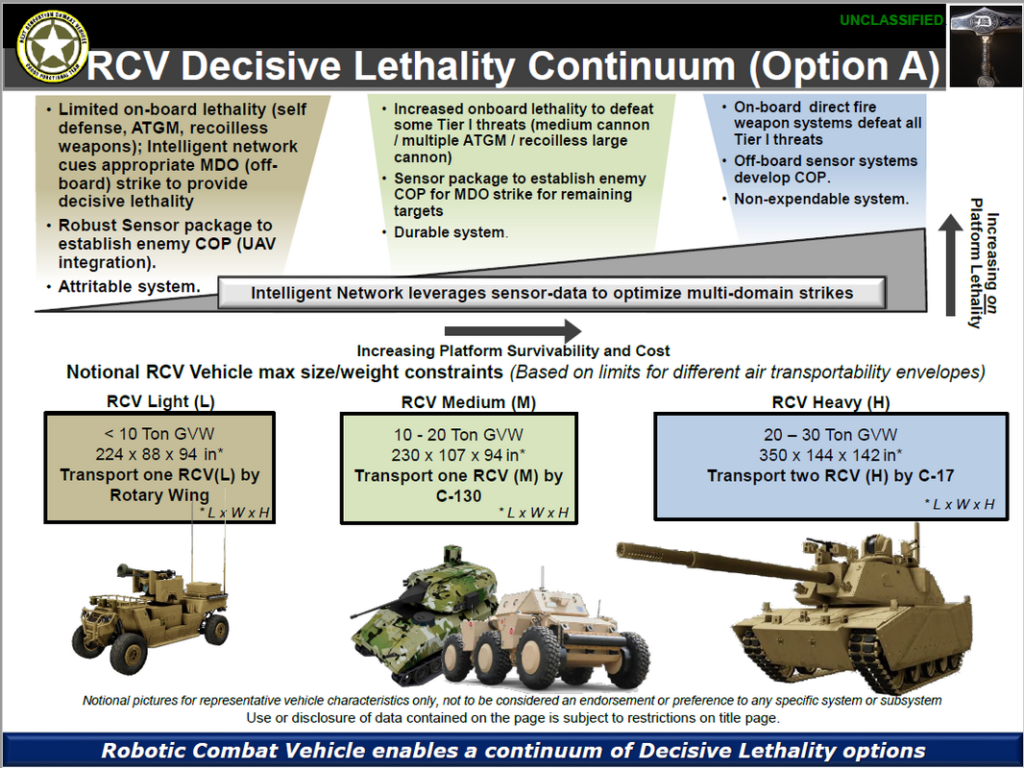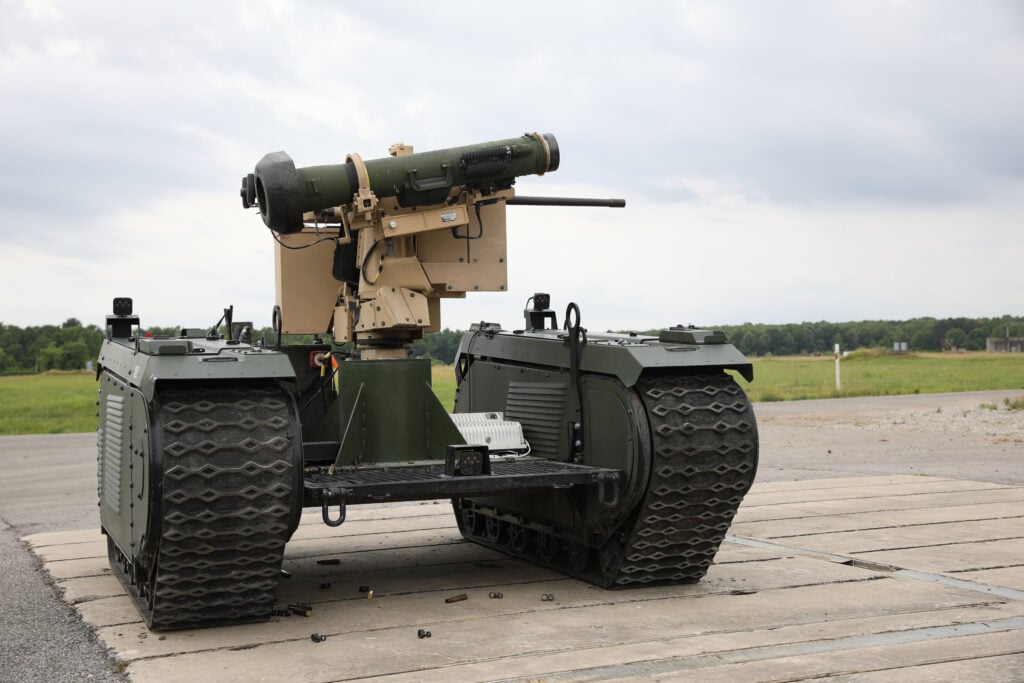
QinetiQ Titan robot fitted with a Javelin anti-tank missile launcher
WASHINGTON: On a future battlefield, seven-ton tracked robots scout the enemy. Some of these Robotic Combat Vehicle (RCV) Light variants sweep paths through minefields. Others pop smoke to conceal the advance. Still others jam enemy transmissions and take potshots with anti-tank missiles.
Enemy return fire rips through the light robots’ unarmored hulls, but their computer brains keep on transmitting target coordinates to the rest of the force. Precision-guided long-range shells pound the enemy position as larger robots move up, 10-ton mini-tanks called RCV-Mediums that boast machine-guns, missiles, and 30mm chainguns. And the third wave follows not far behind: a hard core of humans in M1 Abrams tanks, escorted by wolfpacks of cannon-toting 30-ton RCV-Heavies.
This vision is years from reality, but the Army is experimenting with surrogate unmanned vehicles. Contractor Qinetiq has already delivered the first of four experimental RCV-Lights; Textron is making four Mediums. Building a prototype Heavy awaits progress on Active Protection Systems, miniaturized missile defenses meant to make a modestly armored 30-ton vehicle as survivable in battle as a 70-ton main battle tank.
The whole Robotic Combat Vehicle family will use common navigational software and control interfaces already being field-tested. Each variant will use the same electronic and mechanical standards, a so-called modular open architecture that should let soldiers in the field plug and play a range of payloads, from missiles to smoke generators to radio jammers.
“We understand four soldiers working with a red-lens flashlight in the middle of the night aren’t going to be able to pull off a 30mm turret,” said Maj. Corey Wallace, a young armored cavalry officer with extensive robotics experience now serving on Army Futures Command’s Next Generation Combat Vehicle Cross Functional Team. But, he told the NDIA Armaments, Robotics, and Munitions (ARM) conference last week, the goal is that “most things are modular” and troops in the field can “swap payloads in 30 minutes or less.”
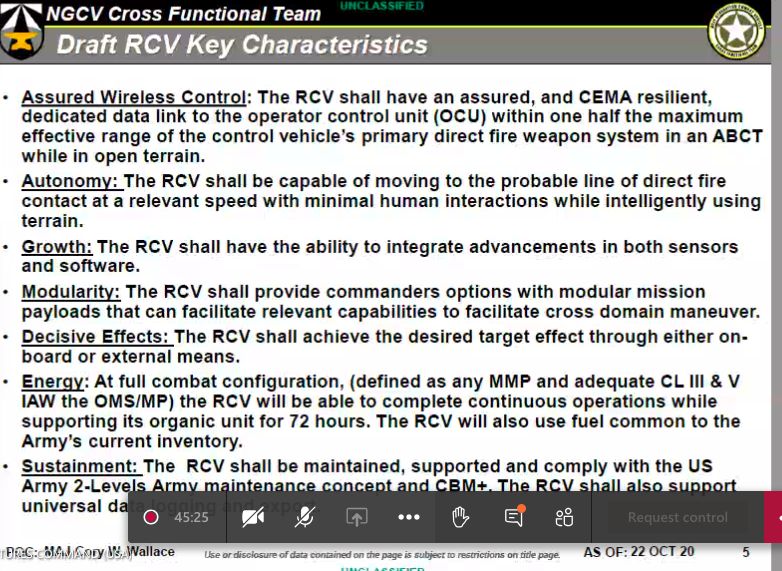
Army draft desired characteristics for Robotic Combat Vehicles, as presented by Maj. Wallace.
What The Army Wants
The NGCV team has already drafted seven desired “characteristics” – not formal, mandatory requirements – for the RCV family:
The priority is assured wireless control, with autonomy in second place. That’s because the Army always wants a human gunner deciding whether to fire. For now, as well, the robots will need a remote-control driver as well, so each RCV requites two human operators, plus a sergeant coordinating each pair of robots.
Why? The software is increasingly adept at navigating around obstacles cross-country, well-trained humans are still better at maneuvering under fire from one covered position to another. So the current plan is to let the robots autonomously make their own way to the front line, but, as they close with the enemy, humans take over by remote control.
Based on field experiments so far, Wallace said, the rule of thumb is that the minimum effective range of the control link between the robot and the manned control vehicle should be at least half the effective maximum range of the control vehicle’s main weapon. That lets the control vehicle shoot at targets the robot spots, while keeping it out of ambushes and minefields the robot stumbles into.
The third and fourth characteristics are that the vehicles should have margin for growth and a modular design, compliant with standards such as the Pentagon Interoperability Profile and VICTORY 2. That way, instead of rewiring proprietary interfaces every time you make an upgrade, you can easily swap in new technologies and specialized payloads from any vendor as they become available.
The top priority payload, based on digital simulations and soldiers’ feedback? Defense against small drones, said Wallace. ISIS has already mounted hand grenades on drones, while Russia used drones to spot targets for artillery in Ukraine, so a future adversary is likely to flood the zone with swarms of scouts. The Army looked into drone-killing lasers, Wallace said, but the power supplies are still too bulky for the lighter RCVs. What’s far more compact and feasible, he said, is a jammer that keeps the drone from reporting your position to enemy artillery.
That brings us to the next priority: electronic warfare. Drones aren’t the only thing the Army wants to jam.
“Yes, you are very lethal [if you] blow the … turret off a tank,” Wallace said, “but you are even more lethal if you paralyze that formation’s ability to communicate.”
Defensively, he said, sometimes the best way to hide from enemy sensors is to pump out so much electromagnetic distortion that they know you’re out there, but they can’t tell where or how many of you there are. And if radiation-seeking missiles do find the jammer, well, it was unmanned.
The third-priority payload plays a similar role: smokescreen generation. Just as jamming hides the force from radio-frequency sensors, smoke hides it from visual ones – including infrared sensors.
The fourth priority: a multi-purpose deathzone detector to warn the human troops of chemical, biological, radiological, or nuclear (CBRN) contamination. There’s no major-war scenario where CBRN detection isn’t useful, Wallace said. While it’s costly to build manned vehicles that can detect poison gas and radiation without endangering their crews, every RCV can have, as standard equipment, a compact short-range detector to warn the human troops following well behind. A long-range detector might be its own full-up mission package. MY ADD DARPA has done a great deal of work on smaller sensors to detect such things.
The fifth priority is handling another type of hazard: minefields and other obstacles. The Army already has an unmanned minesweeper, the M160 flail. Recently, it’s been experimenting with different specialized robots that can work together to clear obstacles while keeping human combat engineers out of range of enemy fire.
Other potential mission modules worth considering, Wallace said, range from anti-aircraft weapons like Stinger missiles to retransmission nodes for battlefield communications – both priority targets for high-tech enemies and at high risk of destruction. Air defense in particular, he said, “that’s the first thing the enemy wants to kill.”
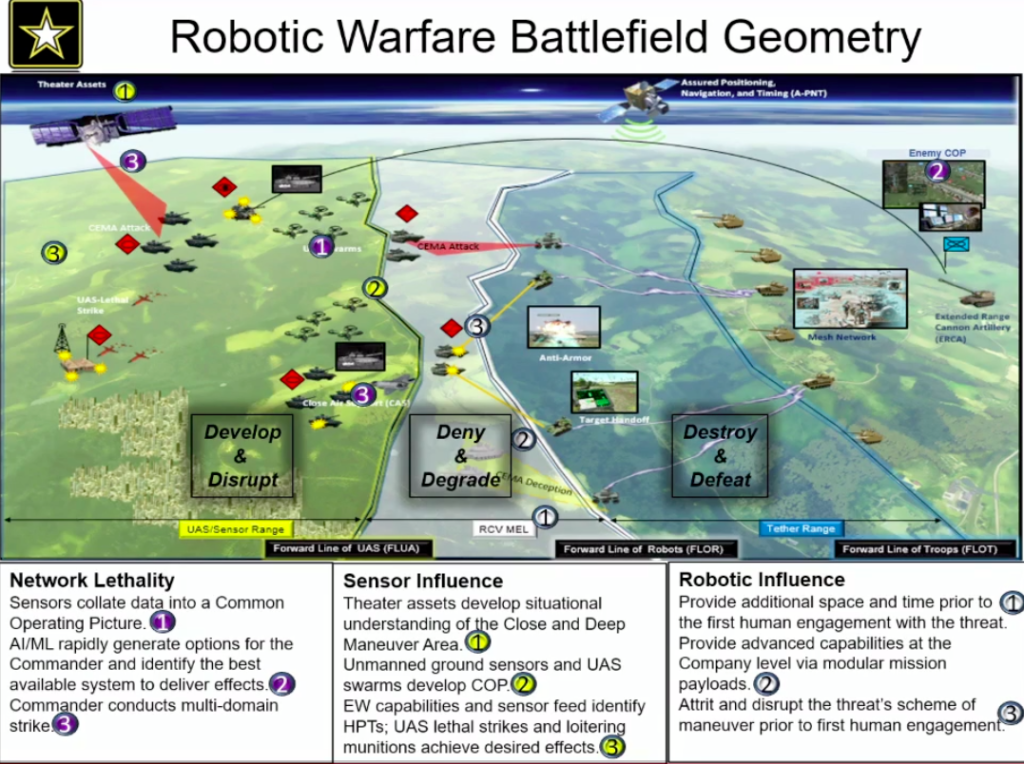
The Army envisions drones and ground robots advancing ahead of humans in future wars. (Enemy forces are at the left of the chart, friendly forces are moving right to left).
Firepower & Armor
Besides these specialized load-outs, the Army wants all Robotic Combat Vehicles to be able to spot targets for the rest of the force – especially for artillery – and to have some onboard firepower and protection. The bigger the RCV variant, the bigger the weapons package and, since it’s less expendable, the heavier the armor.
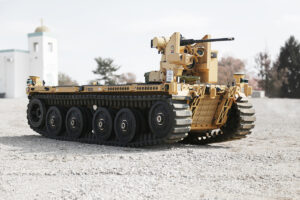
The Qinetiq/Pratt & Miller Expeditionary Modular Autonomous Vehicle (EMAV) in an armed configuration
RCV-Light will carry a single anti-tank guided missile (ATGM) to give it one shot against the toughest targets, but otherwise it’ll be designed to fight infantry and unarmored trucks. That could mean anything from .50 caliber machineguns like the 12.7mm M2, to a grenade launcher like the 40mm Mark 19, to even a 30mm M230 chain gun. A “missile boat” variant might carry a whole rack of ATGMs instead, firing on targets laser-designated by other RCVs . “We want you all in industry to innovate,” Wallace told the NDIA conference.
Defensively, though, it’s not worthwhile to weigh down RCV-Light with armor. Instead, the essential sensors, radio uplink, and computer core should proof against a 7.62 rifle round, so they can keep transmitting target data even when the vehicle is totaled.
“If it loses its ability to fire its weapon, it’s not a big deal. If it loses the ability to move, kind of a big deal but not absolutely a game-changer,” Wallace said. “But it needs to be able to sense and have its brain protected.”
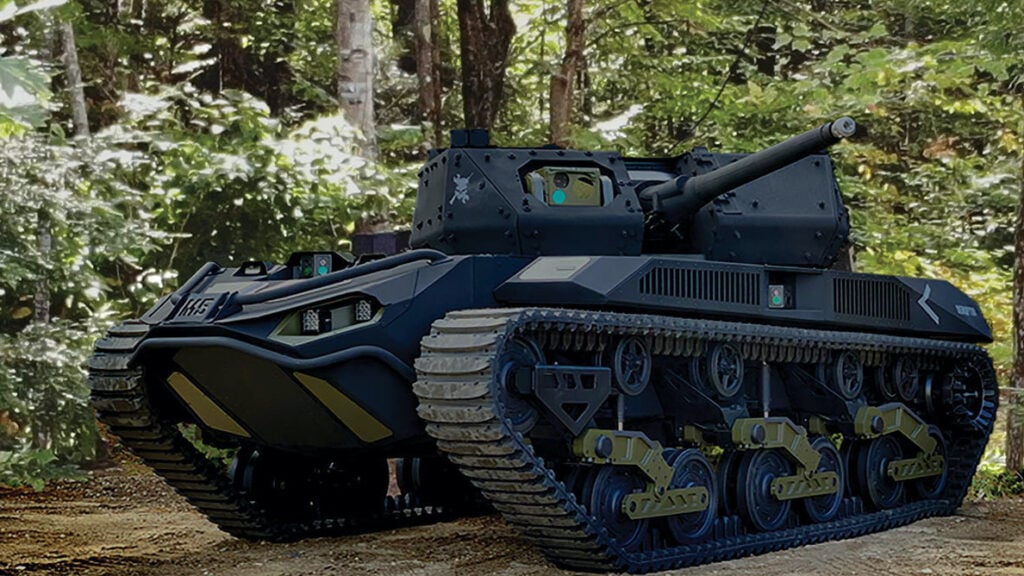
Textron M5 Ripsaw unmanned mini-tank
RCV-Medium, by contrast, is a lot more like a tank. The Medium will carry a pair of anti-tank missiles to counter tanks and high-velocity 30mm autocannon to kill light armored vehicles like BMPs. The Army looked at a 50mm gun, Wallace said, but the weight was too much. Weight may also limit secondary weapons: The Army wants a machinegun atop the turret, able to aim independently at quick, high-angle targets like rooftop snipers, but it may not fit on the Medium.
How heavy is too heavy? Textron’s experimental RCV-M is 10 tons, just three tons heavier than Qinetiq’s RCV-L. While those are not the final designs, the Army does to want keep the Medium well under 20 tons.
Unlike RCV-Light, RCV-Medium will have armor, but not a lot. After studying heavier armor packages, Army decided the Medium only needs to withstand heavy machinegun fire – 12.7mm DShKs and the like – with optional add-on armor against greater threats. And it doesn’t have to be equally well-protected all over, just the brains (as on RCV-L) and the gun turret.
“Its critical function is to be able to shoot,” Wallace said. “It’s not really a big dealbreaker if it can’t move anymore.”
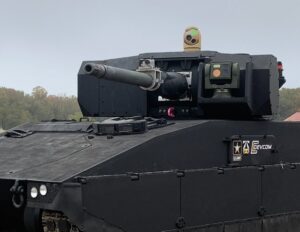
The AI-assisted 50 mm gun, installed on the Army’s ALAS-MC turret, which in turn is on a General Dynamics Griffin chassis
RCV-Heavy is the least clearly defined. It’s meant to be a “robotic tank” with firepower and survivability comparable to the M1 Abrams, Wallace said, but at less than half the weight: 20 to 30 tons, vs. 60 to 70 for Abrams depending on the model and armor kit.
But why does the RCV-Heavy need to be as survivable as an M1 tank, I asked over email, if it doesn’t have human troops inside? Unlike the Lights and Mediums, Wallace responded, the Heavies aren’t mean to operate far ahead of the manned force, but alongside it. It’s intended as a “wingman” maneuvering with the manned tanks, he said, so it has to withstand the same intensity of attacks. You don’t want a barrage of mid-caliber cannon fire can strip the M1s of their RCV-H escort.
“The RCV (H) cannot fulfill its fundamental purpose if it cannot maneuver alongside a tank while in contact with a threat,” Wallace told me. “If medium cannon rounds bounce off an M1A2V3 while they destroy the RCV (H) outright, then one can no longer consider the RCV (H) a decisive lethality wingman.”
Now, making a 20-plus-ton armored vehicle as survivable as 60-plus-tonner is one of the multiple Missions Impossible that sank the Future Combat System 11 years ago. Wallace is well aware of that. A decade later, the Army is urgently putting Israeli-made Active Protection Systems on the M1 Abrams and the 45-ton M2 Bradley. But current APS technology can only shoot down incoming anti-tank missiles, not stop armor-piercing shots from a tank cannon, which move much faster.
“That’s why we’re not going forward with the RCV-Heavy at the same pace, [because] we are acutely aware of the issues that programs like FCS had,” Wallace said. “We’re pumping the brakes with RCV-Heavy. We’re continuing to experiment with surrogates” to test technologies and tactics, he said, “but we don’t want to go full bore until we understand how to do lethality and survivability.”
















